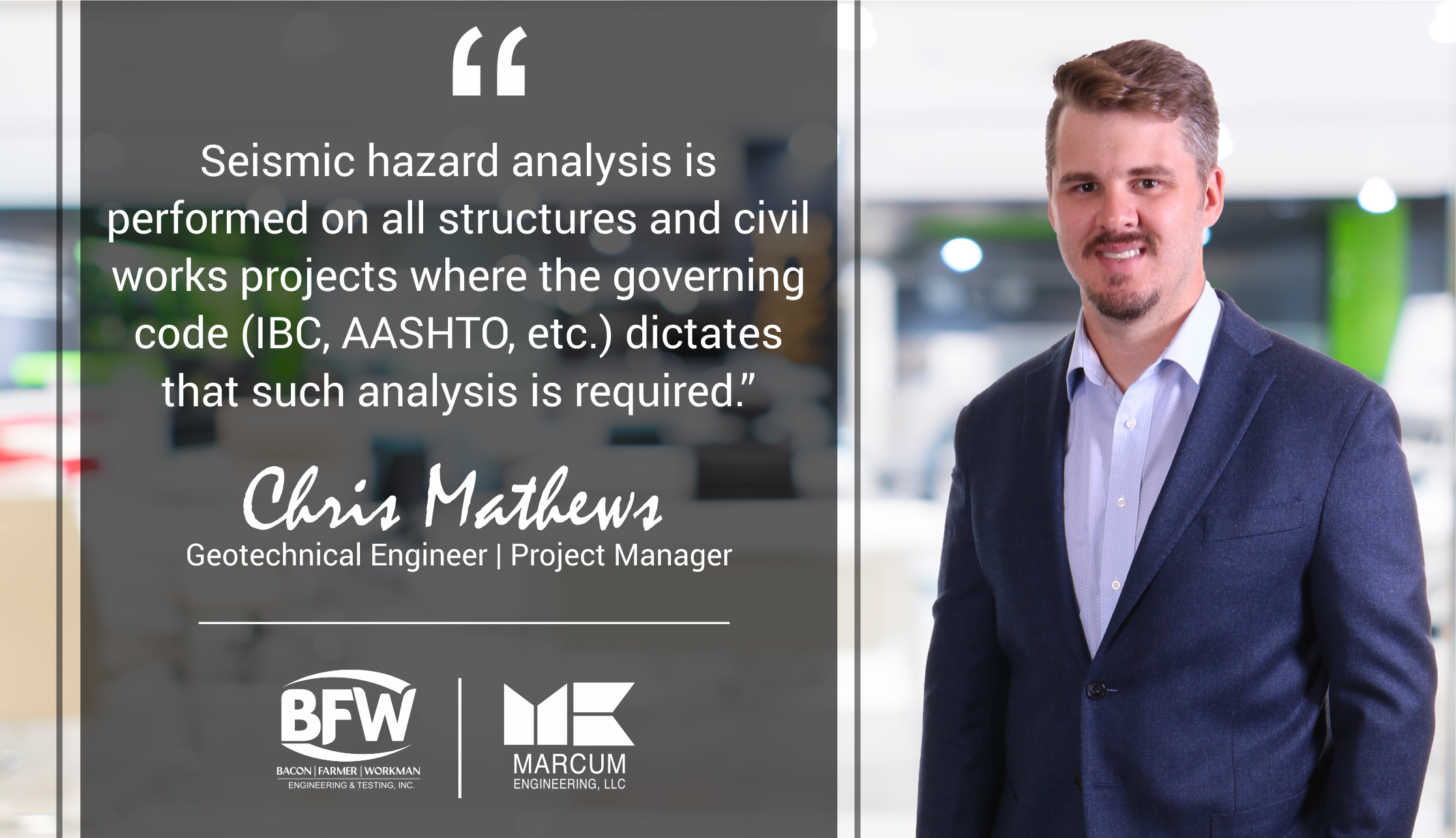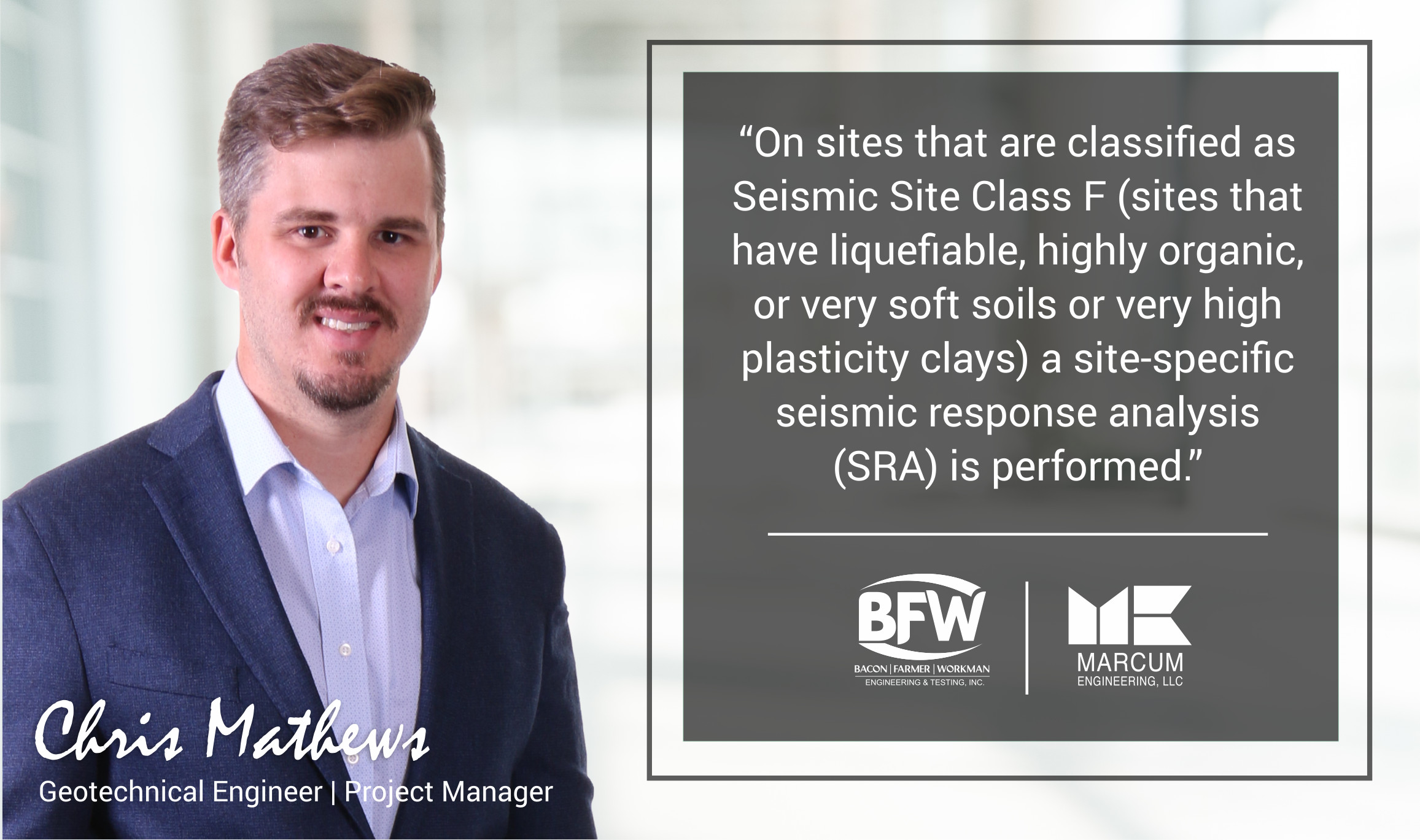Laying the Groundwork with Seismic Analysis
When you think of a building or structure, the last thing you might consider are two very important things about its structural integrity; it moves more than you think, and the soil beneath it may not be as solid as you think.
Seismic analysis is the process we use to understand those two principles when designing a building. No soil is the same, and as a building’s design changes, so too does the way it moves. We asked Chris Mathews, Geotechnical Engineer/Project Manager and resident seismic expert to give us some insight into this discipline. He was all too happy to weigh in on the subject.
Seismic Analysis Keeps Your Buildings Upright
If you’re building anywhere near a seismically active region (you’d be surprised by how many there are in the United States), then you’d benefit from a seismic analysis. Without it, you run the risk of catastrophic failure in the event of even a minor earthquake. While buildings look rigid, they have quite a bit of sway to them. They need enough rigidity to stand tall and enough flexibility to “vibrate” and sway in the event of seismic or high wind activity. If you don’t account for that natural movement, then your building will quite literally fall apart from its own movement.
Chris understands the importance of this kind of analysis in the early stages of construction. In most cases, it’s a requirement.

“Seismic hazard analysis is performed on all structures and civil works projects where the governing code (IBC, AASHTO, etc.) dictates that such analysis is required. It is of particular importance in areas with high seismicity.”
Seismic Analysis Saves Your Building & Saves You Money
Understanding the seismic activity in a region is a discipline all its own. There is a myriad of processes in place to predict how the ground is going to shake during an earthquake and accommodate for it in design. All of these design processes have one commonality; they find the most efficient means of building that works in harmony with the natural movement of the ground. After all, not every building is the same, so it makes sense that not every solution should be the same, either.
Chris’s job is to anticipate that ground movement and work alongside the rest of our seismic and structural team to design a building to accommodate that movement. He dives into that complicated process below:
“The United States Geological Survey (USGS) has published a series of National Seismic Hazard Maps (NSHM) that provide seismic parameters that help engineers predict how strongly a particular site may shake during an earthquake. The maps compile all known (and estimations of unknown) earthquake sources, their distance from the site in question, and other seismological and geological information to predict the maximum expected ground motions at a site over a particular time period.
The simplified methods outlined in the International Building Code (IBC) use the parameters from the NSHM and takes into consideration the soil conditions present on the site via the Seismic Site Class. The Seismic Site Class is determined via one of three methods:
- Shear Wave Velocity Testing – determined via geophysical surveys, most accurate, least conservative
- SPT N-Values – Determined using field testing during drilling least accurate, most conservative
- Undrained Shear Strength – Determined via lab testing performed on samples collected during drilling, middle ground
The simplified method outlined in the IBC adjusts the seismic parameters determined from the NSHM via site coefficients, which are a function of the seismic site class determined using one of the three methods mentioned above. The adjusted seismic parameters are then used to develop the design parameters for the project. In some cases, we can improve the seismic site class by performing shear wave velocity testing compared to what the seismic site class would have been using the SPT N-Value or Undrained Shear Strength methods. This improvement can result in significant savings in the seismic design of the structure.”
Site Response Analysis – Going the Extra Step
Another important aspect of Chris’s job is in classifying job sites under varying seismic design categories, which are what dictate the type and complexity of reinforcement required to ensure a building stands even after seismic activity occurs.
“On sites that are classified as Seismic Site Class F (sites that have liquefiable, highly organic, or very soft soils or very high plasticity clays) a site-specific seismic response analysis (SRA) is performed. A site response analysis can also be used in an attempt to improve the seismic design parameters for a site if shear wave velocity testing does not result in an improvement to the seismic site class. An SRA assesses the effects of site-specific soil conditions on expected earthquake ground motions.”

To simplify this explanation, it might be easier to refer to the adage “too much of a good thing can be a bad thing.” In engineering terms, that can mean that over-engineering a building due to poorly-understood seismic requirements will cost our clients more money with little benefit. Site response analysis, to put it into the simplest terms possible, is to find the perfect balance between safety, durability, and practicality.
The inverse, of course, is obvious. If you design and build a structure that has inadequate support for seismic movement (big or small), then you face disastrous consequences. We can’t stress the importance of this process enough.
When the Earth Shakes, Soil Turns to Liquid
Soil, a liquid? The thought might sound far-fetched, but hear us out. We’ve all done the science experiment in school where we mix corn starch and water to create what our science teachers referred to as a “Non-Newtonian Fluid.” Think about how that material behaves; neither as a solid or as a liquid. Soil, believe it or not, can act in the same manner during an earthquake. The vibrations caused by the shifting tectonics below shake the soil in such a way that it can undergo a process known as “liquefaction”, where it suddenly acts like a liquid. All the structures above; houses, infrastructure, trees, etc. run the risk of sinking into the soil, just like your fingers in that science experiment.
We asked Chris, in regions where the liquefaction risk is high, is it simply impossible to build? Were those a veritable “no man’s land”? His answer reminded us of how much ingenuity goes into modern engineering.
“No site is impossible to build on, it’s just a matter of how much money the developer wants to spend on the seismic design of the structure and/or mitigation of liquefaction.” Chris knows his stuff. Whether you’re on the same page or not, the underlying answer is a simple one. If you have the budget, we have the means of building.
How We Solve Liquefaction
We asked Chris how you deter liquefaction in soil that is prone to it.
“Before we attempt to mitigate liquefaction, it is important to thoroughly evaluate the severity of the issue. Simplified methods of evaluating liquefaction, such as using SPT N-values, can be overly conservative when predicting liquefaction. Utilizing methods such as CPT soundings can allow for a more rigorous evaluation of the liquefaction risk on the site.
If our analysis indicates that liquefaction mitigation is required one of the main methods used is earthquake drains. Earthquake drains mitigate liquefaction by allowing water pressures in the ground to quickly dissipate during an earthquake rather than reaching levels that would cause the soil to liquefy. Other methods for liquefaction mitigation include deep dynamic compaction, stone columns, compaction grouting, soil mixing among a variety of other methods. This is a heavily researched area and new methods are continually being developed.”
Seismic Analysis Keeps Us Grounded
Without seismic analysis, you risk building the next lost city of Atlantis, except this time all of your hard work will plunge into the seemingly hard and compact earth. Worse yet, your buildings could end up dancing themselves to death, like one of those air tube dancers at a used car dealership.
Whatever the case, we think seismic analysis is the perfect embodiment of engineering. It provides a solution to a problem most of us don’t even consider. If you really think about it, that’s a building block of any society. There has to be someone out there willing to build the stuff that holds everything up, even if the job itself is unseen and thankless. People like Chris keep us grounded, literally.

Recent Comments